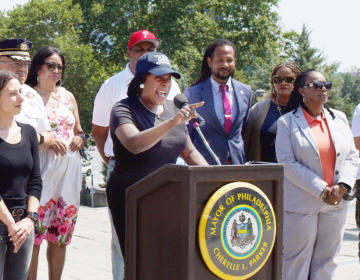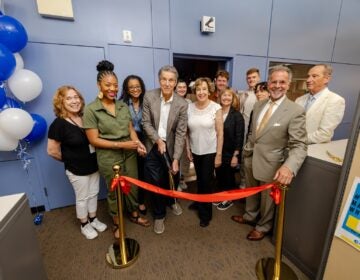The foreclosure crisis hits home
(Revised edition: to correctly identify two agencies)
In 2009, 23-year-old grapic artist Larry Masters had been fighting foreclosure for almost a year. Newly employed after graduating college, Masters kept falling behind on mortgage payments for the two-bedroom house in West Mt. Airy that he’d inherited from his mother.
“Here I was, a 22-year-old kid, and a lot of bills had piled up,” Masters told NewsWorks. “I had food, utilities, house repairs, student loans…At the end of the month I was lucky to have $100 in the bank.” And at least three times in 2008, the bank that held his modest mortgage informed him that if he didn’t make all his back payments, he was going to lose his house. And in January 2009, Masters finally received an “Article 91” notice from his bank — something legally required under Pennsylvania law when a foreclosure is filed, giving homeowners 90 days before the house is sold.
“I was freaked out,” Masters said. He turned to friends and relatives, trying to raise money; “I sold a lot of stuff.” He didn’t want to go to any of the local agencies offering relief, he said, because he feared getting caught up in some slow bureaucratic process. “Those letters wanted that money right away. I knew I had to act quickly. I couldn’t lose this house – I’ve lived here all my life!”
After Masters’ Article 91 notice arrived in 2009, he got lucky, he told NewsWorks: “My friend’s father is on a church committee in New Jersey that works to help homeowners. It was from them that I got enough money” to persuade the bank to call off its foreclosure. “I’m not paid up, but they’ll work with me,” he said. He’s grateful for the assistance, and doesn’t like to think about what would have happened if he hadn’t received it. “I would have lost everything.My mom had put a lot of work in that house, and it had been three years since she died…How could I lose it?”
Foreclosure moratoriums
It’s been hard to gauge what national news, such as stories about the hiring of under qualified personnel by lenders to expedite sometimes-deceptive paperwork in the foreclosure process — might mean locally. But the combined picture is frightening enough, to enough people, that even the sheriff’s office charged with implementing foreclosures has recently been racked with controversy.
At the end of last year, Philadelphia’s Court of Common Pleas imposed a 30-day moratorium on sheriff’s sales of mortgage foreclosures, canceling the planned auction on January 4. That auction, like the December 5 one before it, contained on some familiar leafy blocks: Mt Pleasant, Hortter, Gorgas, and Sydney.
When Barbara Deeley became acting sheriff in January, she confirmed that cleanup was needed, freezing all foreclosures in Philadelphia for 50 days and putting an end to her office’s ethically questionable relationship with a private company that they’d contracted to handle the process.
Now, as Pennsylvania’s Supreme Court is trying to decide if it wants to agree to Deeley’s request to take over the foreclosure process entirely, hundreds of properties and homemakers are in limbo.
Keeping people in homes
Still, local homeowners have more recourse than those in some other parts of the country. “When you think about it,” Masters said, “we do live in a pretty progressive state. In a lot of others I might definitely have lost out sooner.”
Among states, Pennsylvania ranks 20th in the nation in the number of homes under foreclosure – thanks in part to the laws requiring 90-day notice, and other remedies unique to the state. One is the 27-year-old Homeowners’ Emergency Mortgage Assistance Program, pioneered by Rep. Chaka Fattah when he served in the Pennsylvania House.
Another help, more recently established, is the city’s foreclosure courts, run by Judge Annette Rizzo, which work to mediate between distressed homeowners and the lenders claiming their homes. But those courts are full for a reason: a full 11 percent of Philadelphia homes were expected by HUD to enter foreclosure in 2010.
Mt. Airy foreclosures
In 2010 more than 168 homeowners in Mt. Airy received one of those Article 91 foreclosure warnings. The first sign of problems from the outside might be a mailbox full of notices, then a lockbox on the door. “I’ve seen the houses,” said a West Mt. Airy realtor. “Sometimes with toys left behind.”
Still Mt. Airy, like the rest of Philadelphia, has a relatively low foreclosure rate compared with hot spots like Cleveland, Ohio or Fort Myers, Fla. As of November 2010
Mt Airy’s foreclosure rates, according to the nonprofit Reinvestment Fund, are below those for Germantown and West Oak Lane and slightly below the rate for the city as a whole.
Mt. Airy’s 168 foreclosure filings in 2010 for 19119 compare with 278 for 19144 (East Mt Airy, Germantown) and 310 for 19138 (West Oak Lane).
Still. All of these are increases over last year, and West Mt. Airy had the sharpest increase in foreclosures since 2007, at 32 percent.
None of the above numbers includes those like Masters in 2008 – those seeking help before that initial foreclosure notice arrives, after years of trying to cope in other ways. “I kept trying to make it work,” Masters said. “Borrowing here, paying there. Still behind.”
At Rep. Fattah’s Germantown Avenue office, calls asking for help have increased 50 percent since 2009, according to senior policy adviser Cindy Bass. “They often call us when they haven’t received that first notice, but they’re still underwater,” Bass added. Trouble keeping up with the mortgage may be due to job loss in the family, health crises, or other changes, she said, “but most of the time they’ve tried everything else before they come to us.”
Profiteering on misery
‘Everything else’ often includes taking on additional debt, which only exacerbates the problem. Lost Values: A Study of Predatory Lending in Philadelphia, by TRF’s Ira Goldstein, outlines how such lending can trap homeowners into ever-unreachable debt: exaggerated home prices, rapid refinancing that only increases the debt. The result: “systematic extraction of equity from the home.”
The opportunity to sell such loans to homeowners ballooned with the subprime lending industry, whose revenues reached $634 billion nationally by 2006, Each rapid refinancing makes more money for the lenders, and for the brokers — even when it gets to the foreclosure stage.
Stephanie Butler, who for 12 years has been housing counselor at Mt. Airy USA, also sees the pressure of such lending. “I would say 75 percent of my foreclosure clients” have been through some kind of predatory lending, Butler told NewsWorks shortly after a day helping clients navigate Judge Annette Rizzo’s foreclosure court. “I’ve had some trying to juggle 2-3 loans on one house.”
In Northwest Philadelphia, said attorney Beth Goodell with Community Legal Services, the foreclosure threat comes almost entirely from refinancing, especially in the case of older homeowners. “They get in this cycle,” Goodell said, “at every stage there’s some personable young broker telling them about the new loan, this will help make it better.”
Goodell described one case where the only resolution for one elderly Mt. Airy homeowner was a reverse mortgage, because “all the value had been sucked out of the house.” When that homeowner dies, the bank will be able to sell it.
Foreclosures take toll on the community
And the damage goes beyond individual homeowners’ bank accounts. “Foreclosure doesn’t just hurt the homeowner — it’s enormously costly for our neighborhoods,” said Bass. “The value of everyone’s house begins to decline immediately.” Investors from elsewhere buy many foreclosures; while it’s all part of the process, Bass said, “we really prefer these houses stay owned by people who believe in Mt. Airy.”
What parts of Mt. Airy are feeling the pressure most? Bass said her office often hears from parts of East Mt Airy close to Germantown, “especially the stone rowhouses,” and in what she called Lower West Mt Airy, the section between Germantown and Lincoln Drive — the same blocks in which most of the Mt. Airy houses put on sheriff’s sale in December. As you can see in the slide show at the top, these are not homes anyone would call ‘abandoned.’
Right now, with Sheriff Deeley’s suspension of foreclosures, all involved — owners, banks, mortgage investors, even the deputies that handle evictions – are waiting to hear what’s next. And all the advocates listed above, as well as owners in distress, are waiting for the long-promised expansion of Pennsylvania’s HEMAP program with $105 million of new funding promised since October.
“That program is not yet up and running,” said Scott Elliott, spokesman for the Pennsylvania Housing Finance Agency. The new funding is part of a new HUD Emergency Homeowner Loan Program, Elliott told NewsWorks, which is still being finalized; his agency isn’t even taking applications for the new dollars. “We are hopeful that will change in the next month or so.” A few days after Elliott spoke to NewsWorks, the Philadelphia Inquirer lambasted the delay: “HUD needs to act with more urgency to protect the homeowners for whom this aid is intended.”
Two years after his foreclosure notice, Larry Masters told NewsWorks that he feels for people trying to handle this pressure. He said that the first thing homeowners need to do is know that they have rights. “Asking for help,” he said, “is never a bad idea.”
In part two, we’ll profile some of the realtors who’ve been working in this chaotic environment, and ask what changes they’re seeing. We’ll also talk to some now buying in Mt. Airy, and ask what changes this might portend.
WHYY is your source for fact-based, in-depth journalism and information. As a nonprofit organization, we rely on financial support from readers like you. Please give today.




